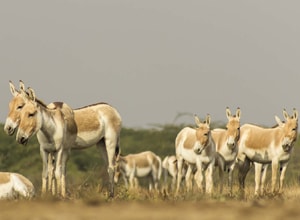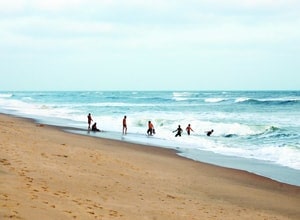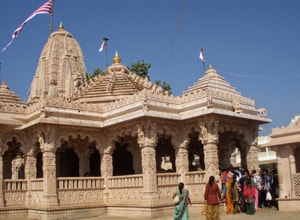






At the far northwest corner of Kutch, facing north across the Great Rann towards Pakistan, stands Lakhpat, once an important port city but now virtually abandoned for almost 200 years. A place where you can imagine the rise and decline of a great port city, and simultaneously contemplate the vast emptiness of the desert and the sea.
When the 1819 earthquake sent the Indus River on its present course to the west and the Great Rann dried up, so did Lakhpat. It was left a humble town around the ruins of its former grandness, now only with Kori Creek that still flows into the Rann . Though it requires a long journey to reach Lakhpat, the intrepid traveler will be rewarded. The 7 km fort walls, erected in 1801 by Jamadar Fateh Muhammed, are still nearly intact, and offer tremendous views out over the Rann. Due to the extremely clear desert air and remote location, the night sky is spectacular (visit near the new moon for best stargazing) and sunrise or sunset in a landscape of such endless horizons are not to be missed.
Lakhpat has religious significance for three of India's most populous religions: Guru Nanak, the founder of Sikhism, reportedly camped here on his journey to Mecca. The site later became a gurudwara, which holds some of Nanak's possessions; Pir Ghaus Muhammed, a Sufi mystic who from the age of twelve devoted himself to spiritual practice and reportedly practiced half as a Hindu and half as a Muslim, is buried here in Lakhpat. His tomb is a stone construction with very complex carvings and a water tank that is said to have healing properties for skin problems; Sayyed Pir Shah's nine-domed mausoleum has intricate carvings, doors, windows and jaalis.
Lakhpat has very few services for visitors; you can buy tea, coffee, and a basic lunch, but do not count on being able to find any other supplies. The only accomodation is in the gurudwara, which is meant more for religious pilgrims than general tourists. Lodging is in the gurudwara dormitory; there are no private bedrooms or bathrooms. For most visitors, spending the night in Narayan Sarovar is recommended, unless you are returning to Bhuj.

The earliest mention of the place can be found in writings of Chinese traveler Hiuen-Tsiang. Hiuen-Tsiang mentioned it as “Kie-tsi-shi-fa-lo situated on the western border of the country close to the river Indus and to the great ocean" of Kutch. According to Hieu-en-Tsiang, Koteshwar port was five miles in boundary near the mouth of the river Indus. There were 80 monasteries with about 5000 monks in them chiefly from the school of Sammityas. In the middle of the completion were thirteen temples of which Mahesh Mandir was full of good monument and where ash-smeared heretics lived. Except some temples, Koteshwar shows few signs of its former greatness.

Like the Wild Ass Sanctuary, Narayan Sarovar is home to a wide array of wildlife, including many species (15 of which are considered threatened) of mammals, reptiles, and birds. The principle species here is the chinkara, an Indian gazelle. In this harsh landscape, only animals well-adapted to the desert climate can thrive, with extreme heat, high winds, and frequent storms. For this reason, many species can be seen here that are not easy to find elsewhere. Most of Narayan Sarovar is desert thorn forest and scrub forest, with some seasonal wetlands and dry savannah-type vegetation as well. Gorad and babul are the prevailing plant species; gorad in the east and babul in the west. Also found among the 252 species of flowering plants in the sanctuary are hermo, ber, pilu, thor, gugal, salai, ingorio, kerdo, carissa, and the invasive “gando baawal” (prosopsis juliflora), though less so than in other nearby areas.

In a land replete with pilgrimage sites, Narayan Sarovar is a different kind of holy experience. At almost the westernmost point of land in India, it can only be reached by traveling over 100 km from Bhuj across the barren scrubland of Kutch. A journey after which the appearance of a vast lake will surprise you even though you have come to see it and its spiritual significance will be tangible. Narayan Sarovar Lake is one of the 5 holy lakes of Hinduism, along with Mansarovar in Tibet, Pampa in Karnataka, Bhuvaneshwar in Orissa and Pushkar in Rajasthan. The lake is associated with a time of drought in the Puranic area, when Narayan (a form of Lord Vishnu) appeared in response to the fervent prayers of sages and touched the land with his toe, creating the lake, now revered as holy to bathe in (though this is not recommended).

Dated around the first century AD, Siyot Caves have an east facing sanctum and an ambulatory. Siyot must have been on of the 80 monastic sites that the 7th century Chinese travellers reported at the mouth of Indus River.

Pingleshwar Beach lies close to Mandvi Kutch and is a wonderful attraction and tourist location.This golden sandy beach of Kutch is worth a visit and is not a frequently visited tourist beach.So you can truly enjoy moments of bliss with your family and friends.Lying about seventeen kilometers from the Coastal NH 8A, it also has proximity to the bird sanctuary of Nalia.The beach is also very popular as a wetland and also beautiful wind farms wherein wind energy is trapped. It also attracts a plethora of migratory birds that come here.

Ashapura Mata Temple, a 14th-century temple, is dedicated to the chief deity of Jadeja Rajputs, Ashapura Mata. The temple was commissioned under the rule of Jadeja dynasty and was constructed by two Karad Vanias- Ajo and Anagor. Ashapura Devi Maa, an incarnation of Annapoorna devi, is popular amongst her devotees as she fulfills desires and wishes of people who pray to her in need. In Gujarat, many other communities worship her as a kuldevi. Origin of the shrine is stepped in antiquity. One can see the references of Ashapura Devi Maa in the Puranas, Rudrayamal Tantra and so on which are all said to point to this shrine in Kutch.